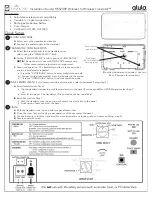
Using Your PSR-2000/1000 with Other Devices
157
PSR-2000/1000
■
Example Keyboard Data
Panel operations on the PSR-2000/1000, such as playing
the keyboard and selecting voices, are processed and
stored as MIDI data. The auto accompaniment styles and
songs also consist of MIDI data.
MIDI is an acronym that stands for Musical Instrument
Digital Interface, which allows electronic musical
instruments to communicate with each other, by sending
and receiving compatible Note, Control Change, Program
Change and various other types of MIDI data, or
messages.
The PSR-2000/1000 can control a MIDI device by
transmitting note related data and various types of
controller data.The PSR-2000/1000 can be controlled by
incoming MIDI messages which automatically determine
the tone generator mode, select MIDI channels, voices
and effects, change parameter values and of course play
the voices specified for the various parts.
MIDI messages can be divided into two groups: Channel
messages and System messages.
■
Channel Messages
The PSR-2000/1000 is an electronic instrument that can
handle 16 channels (or 32 channels, when using the TO
HOST terminal). This is usually expressed as “it can play
16 instruments at the same time.” Channel messages
transmit information such as Note ON/OFF, Program
Change, for each of the 16 channels.
MIDI channels
MIDI performance data is assigned to one of sixteen
MIDI channels. Using these channels, 1 - 16, the
performance data for sixteen different instrument parts
can be simultaneously sent over one MIDI cable.
Think of the MIDI channels as TV channels. Each TV
station transmits its broadcasts over a specific
channel.Your home TV set receives many different
programs simultaneously from several TV stations and
you select the appropriate channel to watch the desired
program.
MIDI operates on the same basic principle. The
transmitting instrument sends MIDI data on a specific
MIDI channel (MIDI Transmit Channel) via a single
MIDI cable to the receiving instrument. If the receiving
instrument’s MIDI channel (MIDI Receive Channel)
matches the Transmit Channel, the receiving instrument
will sound according to the data sent by the
transmitting instrument.
For example, several tracks (channels) can be
transmitted simultaneously, including the style data (as
shown below).
Example: Recording the auto accompaniment of the PSR-2000/
1000 to an external sequencer
Voice number (with what voice)
01 (grand piano)
Note number (with which key)
60 (C3)
Note on (when was it pressed)
and
note off (when was it released)
Timing expressed numerically
(quarter note)
Velocity (about how strong)
120 (strong)
Message Name
PSR-2000/1000 Operation/Panel Setting
Note ON/OFF
Messages which are generated when the
keyboard is played. Each message includes
a specific note number which corresponds
to the key which is pressed, plus a velocity
value based on how hard the key is played.
Program Change
Voice selecting (control change bank select
MSB/LSB setting)
Control Change
Volume, panpot (Mixing Console), etc.
MIDI data has the following advantages over audio data:
• The amount of data is much less, letting you easily store MIDI
songs to floppy disk.
• The data can be effectively and easily edited, even to the point of
changing voices and transforming the data.
The performance data of all songs and styles is handled as MIDI
data.
1
Weather Report
News
2
2
News
MIDI transmit channel 2
MIDI receive channel 2
MIDI
cable
The PSR-2000/1000’s keyboard and internal tone generator are
also connected by MIDI (page 145).
MIDI cable or
serial cable
PSR-2000/1000 track (channnel)
MAIN
LAYER
LEFT
STYLE instrument
STYLE instrument
STYLE instrument
STYLE instrument
STYLE instrument
STYLE instrument
STYLE instrument
STYLE instrument
External sequencer
Track 1
Track 2
Track 3
Track 4
Track 5
Track 6
Track 7
Track 8
Track 9
Track 10
Track 11
Channel 1
Channel 2
Channel 3
Channel 4
Channel 5
Channel 6
Channel 7
Channel 8
Channel 9
Channel 10
Channel 11
















































